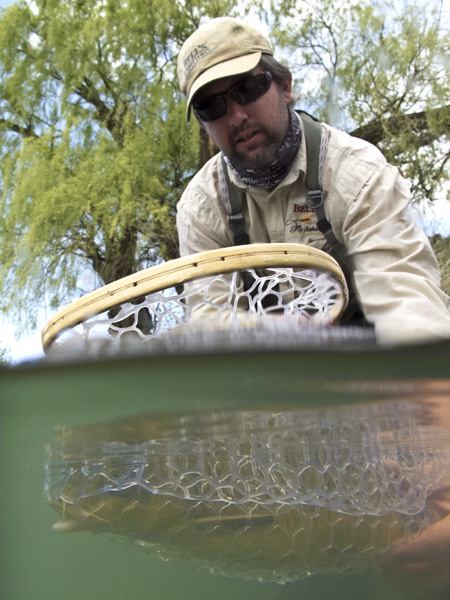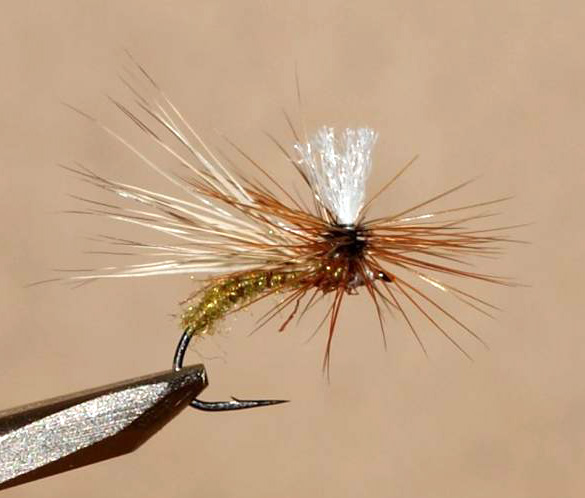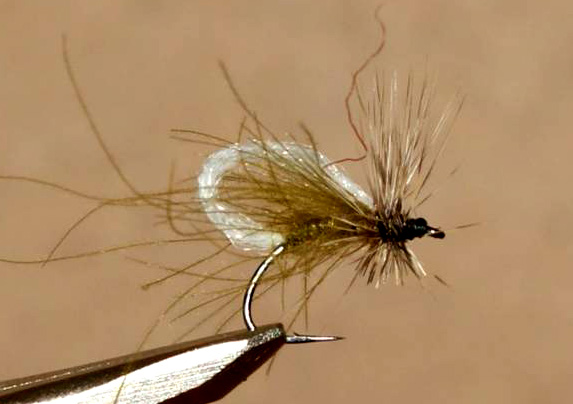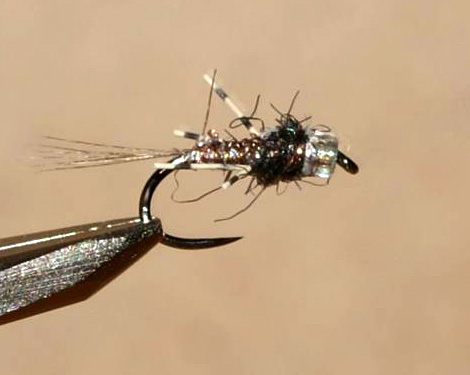Text and pictures Mario Geldenhuys
Mario is a custom rod and landing net maker living in the town of Aliwal North, not far from the beautiful streams of the Eastern Cape Highlands. See http://www.customflyrods.co.za/index.php?option=com_contact&view=contact&id=2&Itemid=60

Simplicity dominates my approach to tying and fishing. Most of my patterns are selected and then usually mutated to fit my personal preference in terms of look and ease of tying. I’m also extremely bad at replicating patterns to the last fibre, and I invariably add, change or take away from a known and proven pattern.
Choosing six patterns only is tough. I have tried to provide something “different” as well as something that catches fish. The patterns below are versatile and can be tied in a wide variety of colour combinations and bead colours and sizes (nymphs) to represent and match the insects found in most of our streams.
Deer Wing Klink/Emerger

Hook: Varivas #16 Floating Nymph & Pupa
Thread: Veevus 16/0 White
Body/Abdomen: Ice Dub UV (Light Olive)
Thorax: Glister Ice Dub UV (Dark Olive)
Rib: Fine copper wire
Wing: Deer Hair
Post: Antron
Hackle: Brown/Ginger
Another “bit-of-everything” fly that has fooled a lot of tough fish for me over the years. A low-floating pattern that can suggest anything from an emerging caddis, to an egg-laying adult, even a cripple at a pinch.
Loopwing CDC Caddis

Hook: Varivas #14 Terrestrial
Thread: Veevus 14/0 Black
Body: 1 CDC feather (Colour of choice)
Wing: White Antron Yarn (tied in a loop)
Hackle: Dun (clipped flush)
I’m a big user of Antron and Z-lon as wings in my patterns. I feel they accept floatant a lot better and are a lot more resilient than deer hair. The only downside for me is that the Antron or Z-Lon splays a lot more after a few fish, and the pattern looses its profile after a while. So a loopwing was the result. Nothing new, but coupled with some CDC and a hackle clipped flush, this pattern has proven to be not only robust, but is a fish taker of note. Olive and Black are my colours of choice in this one.
Puterbaugh Caddis (CDC Version)

Hook: Varivas #14 Terrestrial
Thread: Veevus 14/0 Black
Body: 1 CDC feather (Tan)
Underwing: Foam (Yellow)
Wing: Deer or Elk Hair
Another modified pattern from Dorsey’s book, although the standard pattern catches a lot of fish as is. The hackle on the standard pattern was a bit of overkill for me personally, and I think is more suited to the bigger tailwaters that Dorsey fishes. On our streams a lighter pattern was needed (in my mind anyway). I added some CDC below the foam wing, more for presentation than anything else. The CDC helps the fly to land with a little less “plop” than just the foam wing by itself. I also dropped the hackle usually tied in at the head, and replaced it with either a dubbed CDC head, or a small clipped head as in the fly above. I would fish this pattern is slower water, where a more gentle presentation and better footprint is needed, and the standard hackled pattern in fast riffles or pocket water.
The foam wing on the standard pattern is black, but I prefer yellow and brown to better represent the caddis and stonefly in our streams. I have heard of some good fish being taken on tan and green versions as well.
This pattern (standard and the few variations) will always be in my fly box – it is a killer fly on our streams!
Quill & CDC Nymph

Hook: Dohiku #16 SP Jig Hook
Tail: Olive CDC barbs
Thread: Veevus 16/0 (White)
Body/Abdomen: Hends Body Quill (Olive)
Thorax: Loosely dubbed CDC
Bead: 2mm slotted jig - Tungsten (Gunsmoke)
Another variation based on Darryl Lampert’s CDC Nymph. Body Quill (from Hends) is a favourite material of mine, and I use it as abdomens on predominantly nymphs, but occasionally on dry fly patterns as well (especially Klinks and Parachute patterns).
I usually tie this as a single colour fly, but at times change the thorax to a contrasting colour. I like to vary the bead colour on this pattern a lot. Fly colour and bead combinations are:
Olive and Gunsmoke
Black and Silver
Black and Gold
Black and White
Brown and Gold
Rubberleg Mercury May

Hook: TAFA 102BL #18
Tail: Coq de Leon (3-5 fibres)
Thread: Veevus 16/0 (White)
Body/Abdomen: Holographic Ice dub – Dark Brown
Rib: Fine copper wire
Thorax: Hends Spectra Dubbing Black (Code 45)
Wingcase: Flashabou Ice Blue Pearl (6904)
Legs: Centipede Legs – Mini 0.2mm Speckled
Bead: Silverlined Glass bead, clear (#12)
The RMM is another variation based on a combination of existing patterns. While the silver lined glass beads are nothing new, I really only opened up to them after reading Pat Dorsey’s excellent book “Tying and Fishing Tailwater Flies”. Many theories exist why the silver lined beads work so well. Lafontaine suggests they mimic air bubbles, but after reading Bob Wyatt’s “Trout Hunting, the pursuit of happiness) he suggests not, as no scientific evidence backs this, and according to him, this phenomenon has never actually been recorded. Whatever the reason (bubble or not), there is a significant increase in number of takes (for me) when using patterns where ONLY the glass bead was added (or replaced a standard bead). The rubber legs were added as an afterthought one evening at the vice, and the trout seem to like it as well. As a result they are now standard issue, and I tie very few “plain” Mercury Mays.
Once again, the style remains and the pattern receives changes on colour combinations only, with no other variations.
Jihad Nymph

Hook: Dohiku #16 SP Jig Hook
Thread: Veevus 16/0 (White)
Tail: Coq de Leon (3-5 fibres)
Shellback & Wingcase: Flashabou Ice Blue Pearl (6904)
Body/Abdomen: Hends Spectra Dubbing Black (Code 45)
Rib: Fine copper wire
Thorax: Ice Dub UV (Dark Olive)
Legs: Flashabou Ice Blue Pearl (6904) – 2 strands on both sides of the thorax
Bead: 2mm Silver Tungsten (slotted Jig)
This fly if loosely based on Gary Glen-Young’s G Force (therefore the play on the name – I’m sure Gary will find amusing). Since I prefer buggy and slightly messy looking flies, Gary’s original pattern (although an exceptional pattern) was just too “neat” for me. An essential trigger of the original G Force still remained however, and that is the UV Flashabou. Instead of using it as an abdomen though, I used it as a shellback and wing case. It still has enough flash to attract fish, but allows me to add some dubbing on the abdomen for the slightly buggier look that I prefer. This style of tying now dominates the majority of my nymphs, and generally the only changes are in terms of dubbing colour and bead. Combinations that I use are (abdomen, thorax, bead):
Light Olive, Dark Olive, Silver
Dark Olive, Black, Silver
Tan, Brown, Gold/Gunsmoke
Black, Black, White/Gunsmoke
With these colour combinations and changes in beads colour (and size of the bead) I have found that I can imitate most of the mayfly nymphs in our streams. It is only in extreme cases where these flies will not take fish and more specific patterns need to be tied to the tippet.



